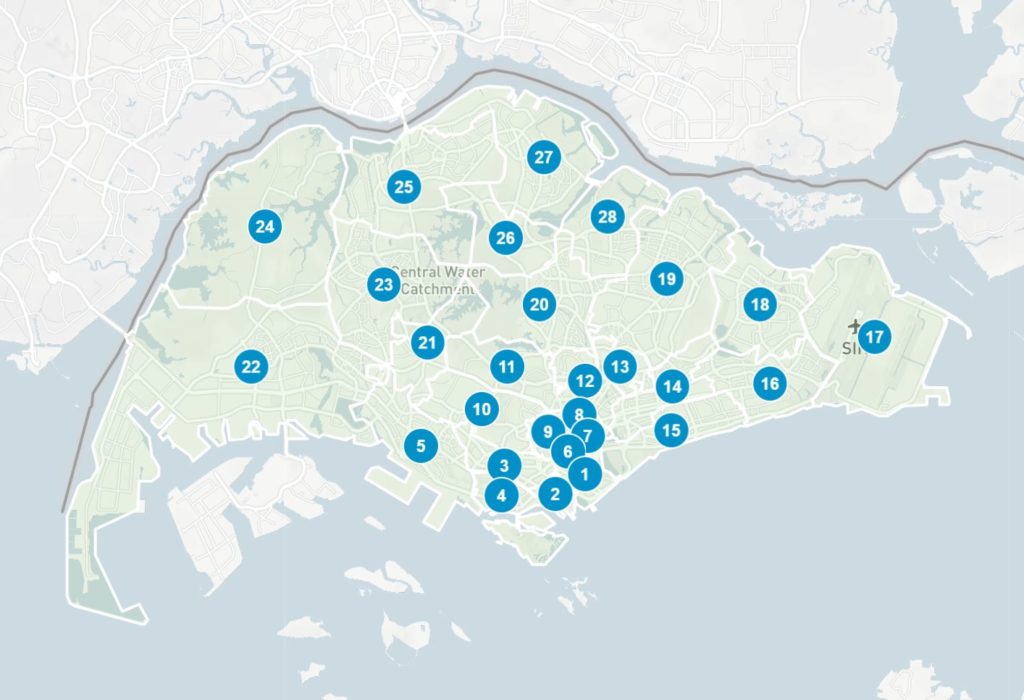Guide to Buying Property in Singapore as a Foreigner.
BUYING IN SINGAPORE

The residential market in Singapore is very diverse and offers a variety of lifestyle options ranging from city living to suburban living; high-rise housing to landed homes; plenty of choices catering to young working professionals as well as families.
Most of the condominiums in Singapore are equipped with facilities such as gyms, swimming pools, barbecue pits, playgrounds and 24-hour security. Landed residential properties are also available for lease. Expatriates staying in landed properties usually choose to join recreational clubs to socialise and for the facilities which are not available in landed homes.
There are no restrictions to foreign ownership of condominiums. However, purchase of landed properties by a foreigner (individual or company) is subject to written permission from the Land Dealings Approval Unit.
Although small compared to other regional countries, buying a property in this affluent city-state is considered a blue-chip investment.
Singapore is also known for good governance, political stability, transparency, efficiency and ease for doing business. This has helped put Singapore on the radar among foreign investors and made it an attractive property market. Another reason why foreigners like Singapore is the strength and stability of the Singapore economy and Singapore Dollar.
You are considered a foreigner if you are not a Singapore citizen, a Singapore company, a Singapore limited liability partnership or a Singapore association.
What you can and cannot buy
Under the Residential Property Act, a foreigner can buy public housing or private property without approval from the Singapore Land Authority (SLA).
Public housing
The public housing market falls under the Housing and Development Board (HDB) with certain restrictions.
Eligibility
Here are several property types that foreigners are eligible to buy:
#1. If you’re a non-Singapore Permanent Resident (SPR) buying alone:
You can buy a resale executive condominium (EC) that is more than 10 years old
#2. If you’re a Singapore PR buying alone:
You can buy resale EC that is more than five to nine years old.
#3. If you’re jointly buying as Singapore PRs, you can buy:
- A resale HDB flat (3 years after obtaining your PR)
- A resale EC that is more than five to nine years old
- A resale EC that is more than 10 years old
#4. If you’re a jointly buying as a couple (one Singapore PR and a non-Singapore PR):
- A resale EC that is more than five to nine years old
- A resale EC that is more than 10 years old
#5. If you’re jointly buying as non-Singapore PR couple
- A resale EC that is more than 10 years old
Buying a private property
Unlike public housing, private properties have much lesser restrictions and are probably what you’ll be more favourable in buying. They also come with better fittings, designs and are generally closer to the Central Business District (CBD). If you’re buying a private condominium, they also come with facilities such as swimming pools, gyms, saunas, and more. The flip side is that they are more expensive compared to public housing.

Eligibility
Here are the common property types that foreigners are eligible to buy:
- An apartment or condominium unit
- A strata landed house in an approved condominium development
- A leasehold estate in a landed residential property for a term not exceeding seven years, including any further term which may be granted by way of an option for renewal
- A landed property on Sentosa Cove
Restrictions
There are restrictions when buying a landed property on the main island of Singapore.
As such, you will need to write to the Land Dealings Approval Unit when looking to purchase the following:
- Vacant residential land
- Terrace house
- Semi-detached house
- Bungalow/detached house
- Strata landed house which is not within an approved condominium development under the Planning Act (e.g. townhouse or cluster house)
- Shophouse (for non-commercial use)
The approval is on a case-by-case basis.
Applicants stand a better chance if they can show proof that they have made an “exceptional economic contribution to Singapore”, as SLA puts it.
How to apply
You can contact SLA at 6478-3444, or apply online on SLA’s website.
Alternatively, you can visit them at the following address: Land Dealings Approval Unit, Singapore Land Authority, 55 Newton Road, #12-01 Revenue House, Singapore 307987
Check if you need to pay taxes
Foreigners are required to pay Additional Buyer’s Stamp Duty (ABSD) when buying private property in Singapore.
SPRs buying their first residential property will need to pay an ABSD rate of 5% and 15% for their second and subsequent residential property.
Meanwhile, foreigners will need to pay an ABSD rate of 20% regardless of the number of residential properties purchased.
Summary of Singapore Districts
Prime residential districts of 9, 10 and 11 remain the top choices for foreign investors and expatriates relocated to Singapore. Attraction in these districts include the prime shopping belt of Orchard Road; famous international schools and local schools; Holland Village and Dempsey which are the favourite F&B enclaves for both expatriate and locals alike.
Over the years the Marina Bay, Shenton and Tanjong Pagar areas, which are located within the Central Business Districts (CBD) – District 1 and 2, have grown in popularity largely due to government initiatives in enhancing the attractiveness of the CBD as a live, work and play area. The last few years also saw the completion of a number of luxury condominiums and un-gated landed homes situated in Sentosa, an island approximately 20 minutes’ drive from the CBD.

Central
The central area in Singapore is the most convenient and accessible location you can live in, with major shopping malls surrounding the areas and daily necessities within easy reach. There are plenty of international schools located in the Central area as well, which you should take into considerations if you have school-age children. So if you wish to live centrally in Singapore then consider Districts 1 to 15 and 21. Check out below for a description of each district.
| District | Areas | Location |
|---|---|---|
| 1 | Marina Area | Boat Quay, Chinatown, Havelock Road, Marina Square, Raffles Place, Suntec City |
| 2 | CBD | Anson Road, Chinatown, Neil Road, Raffles Place, Shenton Way, Tanjong Pagar |
| 3 | Central South | Alexandra Road, Tiong Bahru, Queenstown |
| 4 | Keppel | Keppel, Mount Faber, Sentosa, Telok Blangah |
| 5 | South West | Buona Vista, Dover, Pasir Panjang, West Coast |
| 6 | City Hall | City Hall, High Street, North Bridge Road |
| 7 | Beach Road | Beach Road, Bencoolen Road, Bugis, Rochor |
| 8 | Little India | Little India, Farrer Park, Serangoon Road |
| 9 | Orchard | Cairnhill, Killiney, Leonie Hill, Orchard, Oxley |
| 10 | Tanglin | Balmoral, Bukit Timah, Grange Road, Holland, Orchard Boulevard, River Valley, Tanglin Road |
| 11 | Newton | Chancery, Bukit Timah, Dunearn Road, Newton |
| 12 | Toa Payoh | Balestier, Moulmein, Novena, Toa Payoh |
| 13 | Central East | Potong Pasir, Macpherson |
| 14 | Eunos | Eunos, Geylang, Kembangan, Paya Lebar |
| 15 | East Coast | Katong, Marine Parade, Siglap, Tanjong Rhu |
| 21 | Central West | Clementi, Upper Bukit Timah, Hume Avenue |
East
The East Districts of Singapore are the nearest to the airport. If you travel overseas often and wish to reduce your time to and fro from the airport, then the East is a location you might want to consider. Additionally, the East is becomingquite a business hub, so is again convenient for those who wish to reduce their daily office commute time.
| District | Areas | Location |
|---|---|---|
| 16 | Upper East Coast | Bayshore, Bedok, Chai Chee |
| 17 | Far East | Changi, Loyang, Pasir Ris |
| 18 | Tampines | Pasir Ris, Simei, Tampines |
North-East
Singapore does not technically have any “Southern” districts, as the southern area of the island is considered the “Central” districts. However, we do have an area known as the Northeastern part of Singapore, where the largest town is Hougang with the population of 800,000+. This region is mainly made up of newly developed towns like Punggol and Sengkang; you’ll find more young newly-wed couples or young families in the areas.
| District | Areas | Location |
|---|---|---|
| 19 | North East | Hougang, Punggol, Sengkang |
| 20 | Ang Mo Kio | Ang Mo Kio, Bishan, Braddell Road, Thomson |
| 28 | North East | Seletar, Yio Chu Kang |
West
The West Region is the largest (by size) area in Singapore and has a population of over 1 million living in the area, with Jurong West being the largest town. This region is mostly made up of industrial estates and warehouses, so if your company is in the heavy-duty industry, then your office is quite likely to be based in this area. The West is a location you might wish to consider if you don’t wish to invest too much of your time commuting each day.
| District | Areas | Location |
|---|---|---|
| 22 | Far West | Boon Lay, Jurong, Tuas |
| 23 | North West | Bukit Batok, Choa Chu Kang, Hillview Avenue, Upper Bukit Timah |
| 24 | Far North West | Kranji, Lim Chu Kang, Sungei Gedong, Tengah |
North
As the name implies, it is the northernmost region of the country and has a population of at least 400,000. By far, it is mostly under-developed and has an abundance of nature and greenery. Woodlands, the largest town in this region, is the nearest location to our neighbor, Malaysia. Linked by a causeway, it is possible to travel to and from Johor every day. Below you can find a brief district guide for North:
| District | Areas | Location |
|---|---|---|
| 25 | Far North | Admiralty, Woodlands |
| 26 | North | Tagore, Yio Chu Kang |
| 27 | Far North | Admiralty, Sembawang, Yishun |

